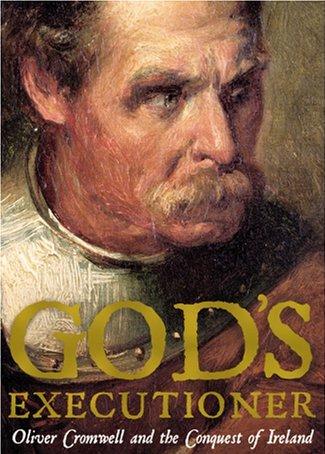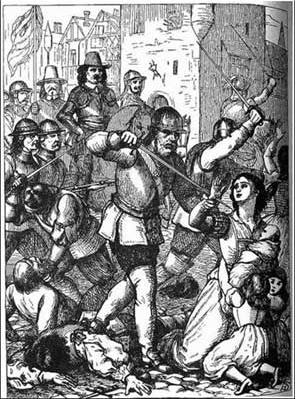The Noble Society of Celts, is an hereditary society of persons with Celtic roots and
interests, who are of noble title and gentle birth, and who
have come together in a search for, and celebration of, things Celtic.
"Winter Edition 2010/11"

God's Executioner: Oliver Cromwell and the Conquest of Ireland
By Dr. Micheal O Siochru
Format: Paperback 336 pages
Published Publisher
21/08/2008 Faber and Faber
ISBN
9780571241217
Synopsis
Cromwell spent only nine months of his eventful life in Ireland, yet he stands accused there of war crimes, religious persecution and ethnic cleansing. The massacre of thousands of soldiers and civilians by the New Model Army at both Drogheda and Wexford in 1649 must rank among the greatest atrocities in Anglo-Irish history: a tale that makes decidedly uncomfortable reading for those keen to focus on Cromwell's undoubted military and political achievements elsewhere. In a century of unrelenting, bloody warfare and religious persecution throughout Europe, Cromwell was, in many ways, a product of his times. As commander-in-chief of the army in Ireland, however, the responsibilities for the excesses of the military must be laid firmly at his door, while the harsh nature of the post-war settlement also bears his personal imprint.
William Francis Butler:
A Life 1838-1910
by Martin Ryan
ISBN-10: 1843510154
ISBN-13: 978-1843510154
Tipperary-born, Victorian adventurer William Francis Butler is a man ripe for discovery at a time of changing definitions of what it means to be Irish. This fascinating biography describes an atypical Irishman, Bonapartist and O'Connellite in sympathy, who had a dazzling career in the British Army. Butler's life encompassed treks across Canada's prairies in the 1870s (when he founded the “Mounties”), Gladstone's 1884-5 attempts to rescue Gordon from Khartoum; co-respondency in the sensational 1886 London divorce case involving 'sex-goddess' Lady Colin Campbell; command of the imperial forces in South Africa 1989-9; a political career as 1904 Dublin Home Rule Party and 1905 Leeds Liberal Party candidate, and 1908 election to Senator in the new National University of Ireland. He also wrote fourteen books. His wife was a celebrated scene-painter, and his friend, the flamboyant Dubliner Garnet Wolseley, became one of the dominant figures of the British military hierarchy during the scramble for Africa. This biography portrays a sympathetic, anti-jingoistic figure, whose public ambitions were tempered by a concern for the underdog and a late-developing, Parnellite sense of Irish nationalism.


Lieutenant General Sir William Francis Butler GCB, PC, ADC
The Making of the Arms of
Alexander Nicholas James Kevin Joseph Raywalt Bannerman
Although one’s Armory usually should reflect one’s individuality, I discovered that any such representation of myself must include references to my ancestors … literally. Genealogy has been my life since the age of seven. Thus, the illustration at right is symbolic of me through that heritage, each quarter containing references to families behind one of my four grandparents.


The upper left quarter (left) contains a self-created representation of my father’s non-armigerous paternal family (Maike-Raywalt). Since the first three American generations were German carpenters, the family is represented appropriately by three carpenters’ squares on a red background signifying the struggle of labourers and the nobility of character found within that struggle.
The upper right quarter, itself quartered, symbolic of my paternal grandmother’s families (MacIntyre and Lane), recognizes ancient Scottish and Irish history. The MacIntyres of Glencoe intermarried with the noble Campbells of Argyle and with the Johnstons, hereditary pipers for centuries. The Scottish MacIntyre arms were quartered first and second as shown here and are retained; but in the early 1800s, the family removed to Prince Edward Island, Canada, thereby creating a new facet requiring contemporary symbolization. As my great-grandfather MacIntyre was one of the largest strawberry producers on the Island in his time, the second quarter is quartered third with a strawberry plant. The Irish portion of this lineage (also 19th Century immigrants to Canada) is represented in the fourth quarter by symbolism of both places: barry-wavy lines adapted from the Arms of their homeplace (Mountmellick, co. Laois, Ireland), and an acorn representing their Canadian homeplace (named “Mt. Mellick” by them).
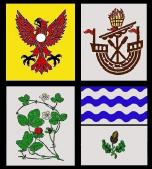
Five armigerous New England families behind my mother’s father are represented in the third quarter (left) of my Arms. The first, containing the Arms of the Prince family, accounts for the earliest clergyman in England identified by me in this lineage. His family’s inclusion symbolizes my early desire to join the priesthood. The second quarter, for the Putnam family of Salem, represents members of that family who were among those lost to 17th Century witch hysteria. They sacrificed their lives to the injustice of misinformation and ignorance. Above Putnam, a bar depicting a portion of the Sherman Arms denotes that family’s role in justice throughout American history. Family members include many persons of influence, including Roger Sherman (the Signer) and General William T. Sherman, who fought to rid the nation of slavery and unify it in a belief to which his cousin before him had seen fit t subscribe the family name. Here, Sherman over Putnam embodies the justice done by some conquering the injustice done to others. In the third quarter are the Arms of Roger Conant, who, as the governor of the Massachusetts colony, served at the will of the people, not of the king, yet was he loyal to the crown. Armigerous in her own right, and to my knowledge my only female ancestor thus endowed, Conant’s wife, Sarah Horton, is represented in the fourth quarter to recognize my female ancestry generally.
The fourth quarter of my Arms (right) is halved to represent my maternal grandmother’s direct descent in the male line from the ancient English family, Shove, which intersects with the Barnums, purportedly of royal descent. This quarter symbolizes the beginning of my knowledge of my colonial American ancestry and my ability to establish myself as a “child of the world” through a royal lineage.
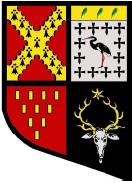
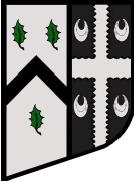
Thus, through a comprehensive representation of my ancestors from whom I have received my identity, my Arms depict how I (and others) see me. These symbols represent heritage, tradition, humility, honour, nobility of character and blood, charity, trustworthiness, knowledge, justice, faith, sacrifice, passion and independence. The motto, Thus, always for history, iterates the personal conviction that in order to recognize where I’m going, I must recognize where I’ve been.
Over time, one’s Arms might be drawn by any number of trained artists, but always only through written description using standardized language. Through research, the blazon reads:
ARMS: Quarterly, I Gules three Carpenter's Squares bendwise Argent (for Maike and Raywalt); II quarterly (i) Or an Eagle displayed Gules and Plate armed Sable (for MacIntyre of Scotland), (ii) Argent a Lymphad Sanguine pennoned with burning forecastle and having between the forecastle and the poop two oars in saltire blades upward sails furled (for Campbell element of MacIntyre of Scotland), (iii) Argent a Strawberry Plant with as many berries as blossoms proper (for MacIntyre of Canada), (iv) per fess the upper half barry wavy of six Argent and Azure the lower half Argent an Acorn Leafed proper (for Lane of County Laois, Ireland and of Prince Edward Island, Canada); III quarterly (i) Gules a Saltire engrailed Erminoise (for Prince), (ii) Argent upon a Bar in chief Or three Oak Leaves proper (for Sherman) and within a bordure Crusily Fitchy Sable a Stork close Sable armed Gules (for Putnam), (iii) Gules ten Billets in pile Or (for Conant), (iv) Sable a Stag's Head caboshed Argent attired Or and for difference a Mullet Or (for Horton); IV impaled, Argent a Chevron Sable between three Holly Leaves proper (for Shove), Sable a Cross engrailed voided Argent between four Crescents Argent (for Barnum).
CREST: On a Torse Gules and Or a Gryphon segreant with queue nowed Gules, holding a Ducal Coronet Or in sinister claw and a Plume Purpure inverted in dexter claw.
MOTTO: Sic Semper Historia...Thus always for History.
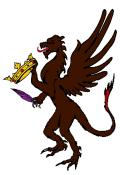
The crest (left) contains a griffin sergeant (modified from the Shove crest), suggesting independence; a ducal coronet, representing multiple noble descents, and a quill, symbolizing love of writing and literature.
